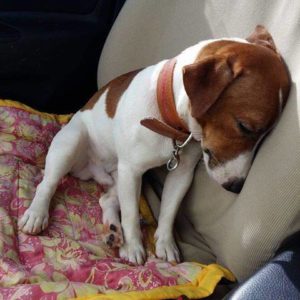Table of Contents
*This post may contain affiliate links. As an Amazon Associate we earn from qualifying purchases.
Separation anxiety happens when a dog that’s hyper-attached to his owner gets super-stressed when left alone. It’s more than a little whining when you leave or a bit of mischief while you’re out. It’s a serious condition and one of the main reasons owners get frustrated with their dogs and give them up. But there are plenty of things you can do to help.
What Is Causing it?
- Being left alone for the first time or when he’s used to being with people
- Change of ownership
- Moving from a shelter to a home
- Change in family routine or schedule
- Loss of a family member
Signs of Separation Anxiety
- Howl, bark, or whine to excess
- Have indoor “accidents” even though he’s housebroken
- Chew things up, dig holes, scratch at windows and doors
- Drool, pant, or salivate way more than usual
- Pace, often in an obsessive pattern
- Try to escape
How To Treat It
1. EXERCISE – Make sure your JRT gets lots of exercise every day. A tired, happy dog will be less stressed when you leave. It’s also key that you challenge your pet’s mind. Play training games and fetch. Use interactive puzzles. Work his mind as well as his body. That will keep him busy, happy, and too tired to be anxious while you’re gone.
A dog with severe anxiety won’t be distracted by even the tastiest treats. You’ll need to slowly get him used to your absence.
2. INCREASE TIME GONE GRADUALLY – He may start to get nervous when he sees signs you’re about to leave, like putting on your shoes or picking up your keys. So do those things, but then don’t leave. Put on your shoes and then sit down at the table. Pick up your keys and watch TV. Do this over and over many times a day.
When your dog starts to feel less anxious about that, you can slowly start to disappear. First just go on the other side of the door. Ask your dog to stay, then close an inside door between you. Reappear after a few seconds. Slowly increase the amount of time you’re gone. Put on your shoes and pick up your keys. Ask your dog to stay while you go into another room.
As he gets more used to the “stay game,” increase the amount of time you’re gone. Then use an outside door, but not the same one you go out every day. Make sure your dog is relaxed before you leave.
Only you can tell if your dog is ready to be left alone for longer periods. Don’t rush things. Give him a stuffed treat when you’ve built up to 10 seconds or so apart. Always act calm when you leave and when you return.
Gradually build up the time until you can leave the house for a few minutes. Then stay away for longer and longer periods.
What DOES NOT Work.
- Many people wonder about getting a pet for their pet so the dog won’t be lonely while they are out. This does not work, because the excessively tight bonding is between you and your dog, not between another animal and your dog. Having company has no effect on the distress your dog feels when you leave.
- Punishment does not work. Dogs do not make the association between making a mess and being punished for it at a later time. They also cannot reason that if they don’t make a mess in the future, they won’t be punished. Even though your dog may look “guilty” when you come home to a mess, he has learned that when you are present and a mess exists, he is in trouble. If someone who had never scolded your dog went into your house, and a mess was present, the dog would not look guilty.
- Tying the dog to chewed objects, or painting them with a hot sauce, may stop him from chewing them. However, the tension he feels will be redirected elsewhere.
Just Become Aware And Patient
Keep in mind, that dogs have emotions too. Jack Russells are loyal and love their owners. Signs of separation anxiety are only seen in the owner’s absence, or when the dog is prevented from being close to the owner (for example, at night). The dog is in a high state of anxiety, or conflict because he wants to be with the owner and is prevented from doing so. Dogs, like people, cannot stay in a high state of anxiety for long and must do something to reduce tension. While you or I might have a relaxing bath, go for a run, or have a drink, the dog can only do “doggy”‘ things to reduce tension. Don’t give up and remember to always consult your veterinarian for behavioral advice.






